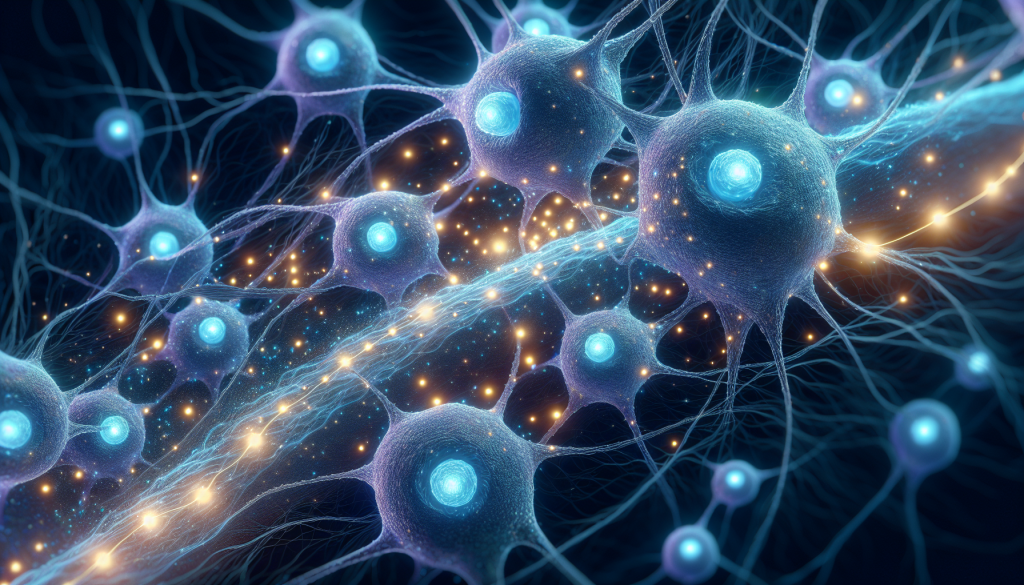Many wonder if there’s a key to unlocking better sleep quality. Enter nitric oxide, a molecule that’s more than a piece of the puzzle—it orchestrates how you sleep. Understanding nitric oxide’s interaction with sleep is crucial, as it affects everything from the depth of your sleep stages to how well you rest. Our exploration of nitric oxide and sleep will shed light on just how this molecule shapes your slumber without falling into common sleep myths or unsupported claims.

Nitric oxide, synthesized by nitric oxide synthase (NOS), is a gaseous signaling molecule and neurotransmitter which plays an important role in the regulation of vascular tone through endothelium-derived relaxing factor (ERDF). It also contributes to inflammation processes and acts as part of sleep wake cycles for controlling resting cerebrovascular tone. Its production in the basal forebrain along with neuronal nitric oxide synthase (nNOS) aids recovery after extended periods without rest or times when one has been deprived from sleeping. During these episodes, it facilitates REM rebound while keeping up stability within certain states associated with deep sleep patterns. Exhibiting relevance towards different mechanisms underlining this biological occurrence.
The Sleep-Wake Cycle is a complex biological procedure which depends on numerous elements, one of them being nitric oxide. Nitric oxide’s contribution to the overall quality and duration of sleep can’t be ignored. It also lessens transitions between Non Rapid Eye Movement (NREM) phases and Rapid Eye Movement (REM), as well as from REM sleep into wakefulness periods, but has no influence over NREM–wake switches. It helps induce both types of sleeping cycles: REM and NREM when missing out on this type – night terrors might occur due to an inadequate level in nitric oxide production causing considerable problems for us in terms of quantity or depth/quality all around restorative time spent dozing off during dark hours activities, hence ensuring healthy intervals are made available with regards to snoozes regularly within each day.
Having appropriate nitric oxide levels is critical to achieve a balanced sleep-wake cycle. Nitric oxide has multiple roles as it functions as both an important neurotransmitter and cerebral vasodilator. This makes the connection between brain activity and blood flow, in particular during active phases of restfulness. Imbalance of nitric oxide concentration can detrimentally impact quality of sleep – too little or excessive amounts affect distinct stages like slow wave or paradoxical dreaming, also REM (Rapid Eye Movement) refreshing rebound after periods without adequate amount of sleeping hours. Impaired NO value could lead to disruptions due to obstructive breathing while asleep syndrome, such as apnea, which drains its presence from entering into that state well being we need for replenishment our organism successfully needs for conserving energy efficient harmony with all biological systems harmonized back again fully recharged toward life’s ultimate goal task!
The production of nitric oxide is a major factor for the maintenance of healthy sleep patterns. Nitric oxide synthases are what generate NO levels, which differ across various stages and can influence how well we’re sleeping. Specifically, NO/nNOS pathways show to have an effect on the REM rebound that occurs after being without restful sleep while NOS1 neurons help in driving both deep non-REM and rapid eye movement phases through generating proper levels of nitric oxide during those times as they go along. Ultimately, it’s vital to keep up with sufficient amounts of nitrogen monoxide throughout our shut-eye if one wishes to get optimum sleep health benefits.

When sleep is deprived, nitric oxide production can be notably impacted. iNOS (inducible nitric oxide synthase) expression is increased as a result of not sleeping enough, ultimately leading to higher amounts of the molecule in wake-active basal forebrain cells. It’s clear that one needs adequate rest for optimal health and functioning.
In wake-active neurons, which show the greatest activity during periods of being awake and in REM sleep, a lack of sleep causes an expression of Inducible Nitric Oxide Synthase (iNOS) that leads to more nitric oxide production. This reaction is experienced when someone suffers from deprived rest or excess pressure on their sleeping patterns. Not surprisingly, this enzyme plays a role in releasing nitrogen dioxide whenever there’s not enough proper shuteye involved. As such, it has been suggested that regular healthy levels of quality repose would benefit those who are dealing with high levels of INOS along with increased amounts of nitrous oxide release because they’re having trouble snoozing peacefully at night.
Nitric oxide is integral to sleep homeostasis, with the accumulation of nitric oxide in the brain’s basal forebrain being essential and adequate for inducing sleep. During obstructive sleep apneic events. There may be a decline in circulating nitric oxide levels leading to disturbances of restful slumber. Modulated auto-inhibition mediated by nitricoxide can have an adverse effect on sleeping patterns, causing shortening or disruption of REM cycles which could manifest as reduced quality and lowered efficacy overall. This may also result in vascular damage due to poor endothelial function caused by inadequate amounts of NO during these episodes.

The vascular tone, vasodilation and blood circulation of the body are all under control by an endothelium-derived relaxing factor or nitric oxide. It is essential to consider managing obstructive sleep apnea since it can greatly increase chances for cardiovascular and cerebrovascular diseases related complications. With a significant role in regards to arterial blood pressure as well, understanding its relation with good sleep hygiene is paramount when aiming at achieving ideal heart health outcomes.
Nitric oxide, an endothelium-derived relaxing factor (EDRF), is essential for sustaining a healthy cardiovascular system by regulating vascular tone. Nitrates and nitrites present in certain foods – such as beets, garlic, meat products like leafy greens or citrus fruits and dark chocolate – can help the body increase its production of nitric oxide, which has direct vasoactive effects beneficial to treating conditions involving sleep issues related to ischemic heart disease. Heart failure and hypertension alike. Endothelial nitric oxide synthase (eNOS) contributes largely towards aiding this process too with respect to blood vessel health overall. As such dietary elements have been linked closely together with increasing levels of EDRF action contributing especially highly into stable control over these vessels throughout any potentially hazardous medical circumstance that may arise within them accordingly without bringing on adverse side affects associated therewith traditionally experienced before alongside medications taken perhaps previously via modern pharmaceutical treatments existing today effectively instead firstly endeavoring naturally ideally only shall avail optimally respectively conclusively speaking finally all said done considerately then Still affirmatively consequently Eventually irrespective importantly summarily likewise justifiably thus ultimately duly culminating Concluding truly aptly Hereafter altruistically meaningfully so perfectly provided hopefully from now forward forevermore henceforth always amenantly sufficiently unambiguously en masse beyond hereinafter equally .
Nitric oxide plays an essential role in regulating blood pressure, and its production can be affected by obstructive sleep apnea (OSA). An increase of sympathetic activation, oxidative stress and inflammation have been linked to OSA. Research has found that individuals with the condition display low levels of nitric oxide as well as correlations between particular genetic variations and the likelihood of having sleep apnea, which could also influence NO output.
Nitric oxide donors are able to autonomously generate this compound so it can boost cerebral blood flow during slumber potentially helping offset abnormal connection coupling thereby improving cognitive function. Such a move may significantly help tackle vascular diseases due to what is known about how issues like heightened sympathetic activity or increased oxidative stress from OSA affect overall wellbeing.

To increase the production of nitric oxide for better sleep quality, there are many natural techniques that can be adopted. These include dietary adjustments such as adding certain supplements to your daily diet and making regular physical activity a part of your life.
These methods have been proven effective in improving restful sleep while also bringing other benefits towards overall health.
For producing nitric oxide, dietary sources which are rich in nitrates and nitrites include garlic, carrots, leafy greens such as spinach or chard, celery, cabbage, beets, citrus fruits and lettuce. Eating foods with high levels of these compounds can help to increase the body’s creation of this molecule.
The most beneficial supplements for aiding in optimal nitric oxide production are L-arginine capsules, CrazyBulk Nitric-Max Capsules, VigRX Nitrics Supplementation Tablets, Transparent Labs NO2 supplement pills and Beetroot Juice. These aids may aid individuals to attain improved quality and duration of sleep due to their effects on enhancing synthesis rate ofnitricoxide levels in the body.
When it comes down to increasing nitrogen oxides concentrations within the body through food consumption or supplementation approaches -options like beetroots, vegetables, garlic, celery, leafy greens, lettuce, cabbage, carrots, and citrus fruit have the capability to enhance the body’s synthesis process successfully. It will lead to noticeable results in terms of better rest quality and duration.
The production of nitric oxide during exercise has a marked effect on both sleep quality and quantity. Regular physical activity is an effective way to stimulate the release of this molecule, which influences recovery time from fatigue or deprivation-related exhaustion as well as aiding daily homeostatic rest cycles that include non-REM sleep. Aerobic activities such as walking and jogging combined with resistance training can be particularly useful for stimulating increased amounts of nitric oxide into the system. Doing so also results in improved REM rebound after periods without sufficient slumber.

Nitric oxide production starts to decrease around middle age, approximately 40 years of age. This has been connected with lessened physical ability and a decline in physiological function, exercise performance, as well as cardiovascular risk due to weakened skeletal muscle blood flow. All these factors combined can have an adverse effect on overall health and wellness.
To combat the decline in nitric oxide production with age, there are several strategies that can be used. Exercise is an effective way to boost nitric oxide output for older adults. Along with eating foods high in antioxidants and dietary nitrates, which increases bioavailability of this key element. By doing so, one may experience improved cardiac health plus better exercise performance as well as sustained normal blood pressure levels.
Incorporating physical activity into their lifestyle along with consuming specific nutrients such as dietary nitrate have potentials to heighten circulation of nitrogen monoxide thus providing various benefits that could enhance overall wellbeing among elderly individuals alike.
Research has been conducted to analyze how Nitric Oxide Plus can support and improve sleep. This powerful blend is said to boost nitric oxide production by 800% – 1200%, more than any other product available today.
Investigations have assessed the efficacy of this supplement in optimizing sleeping patterns. Making it a popular choice amongst people looking for relief from fatigue, insomnia, jet lag, etc.
Nitric Oxide Plus brings various benefits, including improved sleep quality due to its presence in the basal forebrain, which is fundamental for a restful night of sleep. It can also help keep cardiovascular health at optimal levels and normalize blood pressure as well as increase muscle pump and circulation throughout the body. It bolsters your body’s natural defense system while slowing down aging processes too.
Nitric oxide (NO) is known for its many roles in the immune system such as modifying it, fighting inflammation and eradicating tumors. Glial cells like microglia have enzymes called nitric oxide synthase which help them to produce NO. It also helps with sleep homeostasis by governing sleepiness, setting up a regular sleeping pattern, and improving deep and REM sleeps alike. Nitric oxide’s significance related to regulating how we rest cannot be understated. From affecting slow-wave slumber to facilitating rapid eye movement during our time spent asleep, all serve an important purpose of sustaining optimal health through maintaining normal functions concerning wakefulness too!
It is clear that nitric oxide plays a crucial role in regulating sleep and the circadian rhythm. Sleep deprivation can influence how much of this gas is created, particularly relating to its relationship with iNOS expression. By looking at cardiovascular implications such as blood pressure or apnea, we see why getting adequate amounts of rest should be viewed as vital for overall health maintenance.
There are numerous natural methods to increase nitric oxide production before bedtime. Including diet-based sources like certain foods and supplements, all the way up to physical activity which may help enhance respiration rate during periods of shuteye. Additionally, although diminishing levels over time come hand-in-hand with aging, there are also means available on counteracting age related drops in generation rates too when it comes to Nitric Oxide Plus products designed explicitly for these goals pertaining sleep quality improvement purposes specifically speaking.
Hereof,we have managed covering extensively both existing scientific theories pointing towards excellent correlation between biochemical compound NO (nitiric oxixe) and multiple sleeping pattern mechanisms processes thus making feasible our understanding thereof issues regarding regulation cycles qualiry management actions et cetera relevant wide array of matters following from said analysis thematic closely related thereto.
Taking a nitric oxide supplement prior to sleep can be advantageous in that it helps restore any depleted levels of nitric oxide throughout the night. The components present within these supplements support its production in our body.
It’s essential to take notice of the tell-tale signs associated with low nitric oxide levels, such as mental fatigue, erectile dysfunction, hypertension (high blood pressure), poor circulation and cognitive impairment. If any of these symptoms manifest themselves in an individual, it is imperative they see a medical practitioner straight away. An abundance of caution can go a long way when health concerns are involved. So if you believe your nitric oxide could be depleted, then make sure that you contact a healthcare provider.
Adding L-citrulline to your evening regimen could be advantageous for sleep quality, aiding in relaxation and hormone regulation. The results of this may even go so far as bolstering general wellbeing. To get the most out of it, experts suggest incorporating the ingredient into nighttime habits on a regular basis, a move which has been shown to significantly improve sleeping patterns overall.
Nitric oxide has been found to be beneficial for various health benefits such as controlling blood pressure, lowering the chance of heart diseases, improving physical performance during exercise and helping with conditions like erectile dysfunction. It can promote a better circulation in order to transport oxygen faster around our bodies as well as improve cardiac wellness.
Nitric oxide is a major element in controlling the sleep-wake cycle and its related mechanisms, having an influence on both how long we rest for as well as our overall quality of sleep. It also produces while sleeping, making it key to regulating periods of rest. Nitric oxide plays a fundamental role when it comes to good night’s sleep!
Stay updated with the tips, and exclusive offers from C&H Wellness
COPYRIGHT @ 2025 CARDIO AND HEART WELLNESS